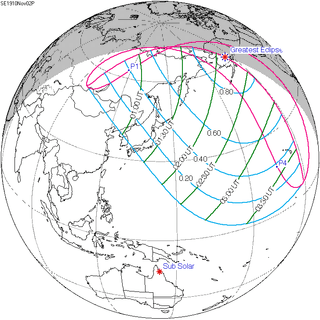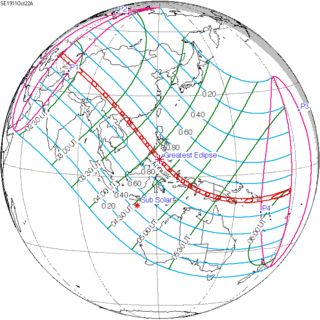Solar eclipse of September 30, 1913
| Solar eclipse of September 30, 1913 | |
|---|---|
 Map | |
| Type of eclipse | |
| Nature | Partial |
| Gamma | -1.1005 |
| Magnitude | 0.8252 |
| Maximum eclipse | |
| Coordinates | 61°00′S 11°36′E / 61°S 11.6°E |
| Times (UTC) | |
| Greatest eclipse | 4:45:49 |
| References | |
| Saros | 152 (7 of 70) |
| Catalog # (SE5000) | 9311 |
A partial solar eclipse occurred on September 30, 1913. A solar eclipse occurs when the Moon passes between Earth and the Sun, thereby totally or partly obscuring the image of the Sun for a viewer on Earth. A partial solar eclipse occurs in the polar regions of the Earth when the center of the Moon's shadow misses the Earth.
Related eclipses
Solar eclipses 1910-1913
Each member in a semester series of solar eclipses repeats approximately every 177 days and 4 hours (a semester) at alternating nodes of the Moon's orbit.
| Ascending node | Descending node | |||
|---|---|---|---|---|
| 117 | May 9, 1910 Total |
122 | November 2, 1910 Partial | |
| 127 | April 28, 1911 Total |
132 | October 22, 1911 Annular | |
| 137 | April 17, 1912 Hybrid |
142 | October 10, 1912 Total | |
| 147 | April 6, 1913 Partial |
152 | September 30, 1913 Partial | |
References
External links
- Earth visibility chart and eclipse statistics Eclipse Predictions by Fred Espenak, NASA/GSFC
| Wikimedia Commons has media related to Solar eclipse of 1913 September 30. |
This article is issued from Wikipedia - version of the Friday, January 15, 2016. The text is available under the Creative Commons Attribution/Share Alike but additional terms may apply for the media files.

